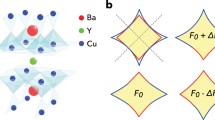Abstract
It is well known that the superconducting transition temperature of high-T c cuprates depends on the number of CuO2 planes in the unit cell. The multilayer structure implies the possibility of interlayer hopping. Under the assumption that the interlayer hopping can be specified by the parameter t ⊥(k) = t ⊥(cos(k x ) − cos(k y ))2, the quasiparticle excitation spectrum for the bilayer cuprate in the superconducting state has been determined in the framework of the t − t′ − t″ − t ⊥ − J* model using the generalized mean-field approximation. It turns out that the interlayer hoppings does not create any additional mechanism of the Cooper paring and does not lead to an increase in T c . The splitting of the upper Hubbard quasiparticle band attributed to the interlayer hoppings is manifested as two peaks in the doping dependence of the superconducting transition temperature at temperatures below the maximum T c value for a single-layer cuprate. It has been found that antiferromagnetic interlayer correlations suppress the interlayer splitting. This probably leads to the common doping dependence of T c for both single-layer and bilayer cuprates.
Similar content being viewed by others
References
X. J. Chen and H. Q. Lin, Phys. Rev. B 69, 104518 (2004).
J. S. Schilling, in Treatise on High-T c Superconductivity, Ed. by J. R. Schrieffer (Springer, Berlin, 2006), Ch. “High Pressure Effects.”
M. Korshunov, V. Gavrichkov, S. Ovchinnikov, et al., Phys. Rev. B 72, 165104 (2005).
M. Korshunov and S. Ovchinnikov, Eur. Phys. J. B 57, 271 (2007).
S. G. Ovchinnikov, I. A. Makarov, and E. A. Shneider, Zh. Eksp. Teor. Fiz. 139, 334 (2011).
D. L. Feng, N. P. Armitage, D. H. Lu, et al., Phys. Rev. Lett. 86, 5550 (2001).
Y. -D. Chuang, A. D. Gromko, and A. Fedorov, Phys. Rev. Lett. 87, 117002 (2001).
A. A. Kordyuk, S. V. Borisenko, M. S. Golden, et al., Phys. Rev. B 66, 014502 (2002).
S. Sahrakorpi et al., Phys. Rev. Lett. 95, 157601 (2005).
T. Kondo, R. Khasanov, Y. Sassa, et al., Phys. Rev. B 80, 100505 (2009).
A. Kaminski, S. Rosenkranz, H. M. Fretwell, et al., Phys. Rev. B 73, 174511 (2006).
L. P. Bulaevskii, E. L. Nagaev, and D. L. Khomskii, Zh. Eksp. Teor. Fiz. 54, 1562 (1968) [Sov. Phys. JETP 27, 836 (1968)].
O. K. Andersen et al., J. Phys. Chem. Solids 56, 1573 (1995).
H. Mori, Prog. Theor. Phys. 33, 423 (1965).
V. V. Val’kov et al., Pis’ma Zh. Eksp. Teor. Fiz. 75, 450 (2002) [JETP Lett. 75, 378 (2002)].
V. V. Val’kov and D. M. Dzebisashvili, Zh. Eksp. Teor. Fiz. 127, 686 (2005) [J. Exp. Theor. Phys. 100, 608 (2005)].
N. M. Plakida and V. S. Oudovenko, Phys. Rev. B 59, 11949 (1999).
R. Hayn, A. F. Barabanov, and J. Schulenburg, Z. Phys. B 102, 359 (1997).
E. I. Shneider and S. G. Ovchinnikov, Pis’ma Zh. Eksp. Teor. Fiz. 83, 462 (2006) [JETP Lett. 83, 394 (2006)].
K. Byczuk and J. Spalek, Phys. Rev. B 53, R518 (1996).
A. F. Barabanov, L. A. Maksimov, and L. E. Zhukov, Physica C 212, 375 (1993).
J. M. Tranquada, D. E. Cox, W. Kunnmann, et al., Phys. Rev. Lett. 60, 156 (1988).
A. Barabanov and O. Starykh, J. Phys. Soc. Jpn. 61, 704 (1992).
A. F. Barabanov and V. M. Berezovskii, Zh. Eksp. Teor. Fiz. 106, 1156 (1994) [J. Exp. Theor. Phys. 79, 627 (1994)].
D. L. Feng, N. P. Armitage, D. H. Lu, et al., Phys. Rev. Lett. 86, 5550 (2001).
U. Welp, M. Grimsditch, S. Fleshler, et al., Phys. Rev. Lett. 69, 2130 (1992).
C. Meingast, O. Kraut, T. Wolf, et al., Phys. Rev. Lett. 67, 1634 (1991).
M. Kund and K. Andres, Physica C 205, 32 (1993).
Author information
Authors and Affiliations
Corresponding author
Additional information
Original Russian Text © I.A. Makarov, S.G. Ovchinnikov, 2011, published in Pis’ma v Zhurnal Eksperimental’noi i Teoreticheskoi Fiziki, 2011, Vol. 93, No. 6, pp. 372–377.
Rights and permissions
About this article
Cite this article
Makarov, I.A., Ovchinnikov, S.G. Effect of interlayer single-particle hoppings on the superconducting transition temperature. Jetp Lett. 93, 339–343 (2011). https://doi.org/10.1134/S0021364011060063
Received:
Published:
Issue Date:
DOI: https://doi.org/10.1134/S0021364011060063




